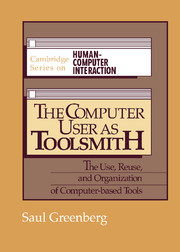Book contents
- Frontmatter
- Contents
- List of figures
- List of tables
- Foreword
- Acknowledgments and dedication
- 1 Introduction
- 2 Studying UNIX
- 3 Using commands in UNIX
- 4 Techniques for reusing activities
- 5 Recurrent systems
- 6 Reuse opportunities in UNIX csh – potential and actual
- 7 Principles, corroboration, and justification
- 8 Organizing activities through workspaces
- 9 A workspace system: description and issues
- 10 Conclusion
- Appendix A A sample trace
- Appendix B Summary statistics for each subject
- References
- Author index
- Subject index
10 - Conclusion
Published online by Cambridge University Press: 26 May 2010
- Frontmatter
- Contents
- List of figures
- List of tables
- Foreword
- Acknowledgments and dedication
- 1 Introduction
- 2 Studying UNIX
- 3 Using commands in UNIX
- 4 Techniques for reusing activities
- 5 Recurrent systems
- 6 Reuse opportunities in UNIX csh – potential and actual
- 7 Principles, corroboration, and justification
- 8 Organizing activities through workspaces
- 9 A workspace system: description and issues
- 10 Conclusion
- Appendix A A sample trace
- Appendix B Summary statistics for each subject
- References
- Author index
- Subject index
Summary
If I send a man to buy a horse for me, I expect him to tell me that horse's points – not how many hairs he has in his tail.
— Carl Sandburg's Abraham LincolnThis final chapter will be brief. First, the argument of the book is reviewed. Next, the original contributions are identified. Finally, new directions for research are sketched. The individual components of the book are not evaluated or criticized because this has been done at the end of each chapter.
Argument of the book
We began with the observation that orders given to interactive computer systems resemble tools used by people. Like tools, orders are employed to pursue activities that shape one's environment and the objects it contains. People have two general strategies for keeping track of the diverse tools they wield in their physical workshops. Recently used tools are kept available for reuse, and tools are organized into functional and task-oriented collections. Surprisingly, these strategies have not been transferred effectively to interactive systems.
This raises the possibility of an interactive support facility that allows people to use, reuse, and organize their on-line activities. The chief difficulty with this enterprise is the dearth of knowledge of how users behave when giving orders to general-purpose computer systems. As a consequence, existing user support facilities are based on ad hoc designs that do not adequately support a person's natural and intuitive way of working.
- Type
- Chapter
- Information
- The Computer User as ToolsmithThe Use, Reuse and Organization of Computer-Based Tools, pp. 159 - 163Publisher: Cambridge University PressPrint publication year: 1993

